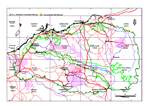Click on images
to enlarge



Photographer: J. Simmons

Thick, corky bark. Photographer: J. Simmons

Photographer: B.R. Maslin
, AA Mitchell 2742, FM_sml.jpg)
Seed from one herbarium voucher. Scale in mm. Photographer: F. McCallum.
Botanical name
Acacia anaticeps Tindale, Contr. New South Wales Natl Herb. 4: 269, pl. 23 (1972)
Common name
Duck-head Wattle
Description
Bushy, glabrous shrubs or trees 2-5(-7) m high. Bark grey, corky, deeply furrowed. Phyllodes inequilaterally obovate-elliptic to sub-flabellate (shape unusual and reminiscent of the outline of a duck's head), broadest near or above the middle, upper margin conspicuously rounded, lower margin ±straight or shallowly concave, mostly 4-7 (-9) cm long and 2-5 (-6) cm wide, coriaceous, green or sub-glaucous; with (3-) 5-7 (-8) main longitudinal nerves and openly-anastomosing minor nerves in-between; rounded or bluntly acute at apex, narrowed towards the base. Inflorescences elongated terminal or axillary racemes or panicles, small (immature) phyllodes often at base of peduncles; peduncles 2-5 mm long; heads globular, small (2-2.5 mm in diameter when dry), cream-coloured, 4-7-flowered. Flowers 5-merous; sepals minute, free. Pods raised over seeds and moderately to deeply constricted between them, 7-22 (-28) cm long, 10-20 mm wide, crustaceous to woody, sub-straight to strongly curved and often variably twisted, brown. Seeds longitudinal in the pods, broadly ellipsoid to globose, mostly 10-14 mm long, dull, brown, turgid but strongly depressed and yellow to light brown at the centre; funicle thickened but not expanded into an aril.
Characteristic features
Bark corky. Phyllode shape unusual (reminiscent of the outline of a duck's head), upper margin conspicuously rounded, lower margin ±straight or shallowly concave, mostly 4-7 (-9) cm long and 2-5 (-6) cm wide, with few main longitudinal nerves and openly anastomosing minor nerves in-between. Inflorescences elongated terminal or axillary racemes or panicles; heads very small, cream-coloured, few-flowered (4-7). Pods long and broad (mostly 7-22 cm x 10-20 mm), sub-straight to strongly curved and often variably twisted, raised over seeds and moderately to deeply constricted between them, crustaceous to woody. Seeds large (10-14 mm long), nearly circular, depressed at centre.
Distribution and ecology
Occurs in the northwest of Western Australia from the northern edge of the Pilbara region northwards to near Broome and inland to between Lake Disappointment and Lake Gregory. Most commonly grows in red sand, on pindan plains or dunes. Also found on heavier, often saline, soils. Acacia anaticeps is not common in the Pilbara; it is known from only a few of localities in the far north of the region.
Flowering and fruiting period
Flowers in May and June. Pods with mature seeds have been collected in August and October (plants with immature pods have also been collected in August).
Affinities
Acacia anaticeps is not likely to be confused with any other Wattle in the Pilbara, and it has no obvious close relatives. It is an invariate, very distinctive species, especially on account if its corky bark, unusual-shaped phyllodes, small, few flowered heads and large pods.
Notes
Regenerates from base of stem following fire.
According to information on one herbarium sheet the seed of A. anaticeps was eaten by aboriginal people, it was cooked in a fire prior to consumption.
Conservation status
Although not common in the Pilbara this species is not considered rare or endangered.
Origin of name
The botanical name is derived from the Latin anati- (duck) and -ceps (head) in reference to the shape of the phyllode.
